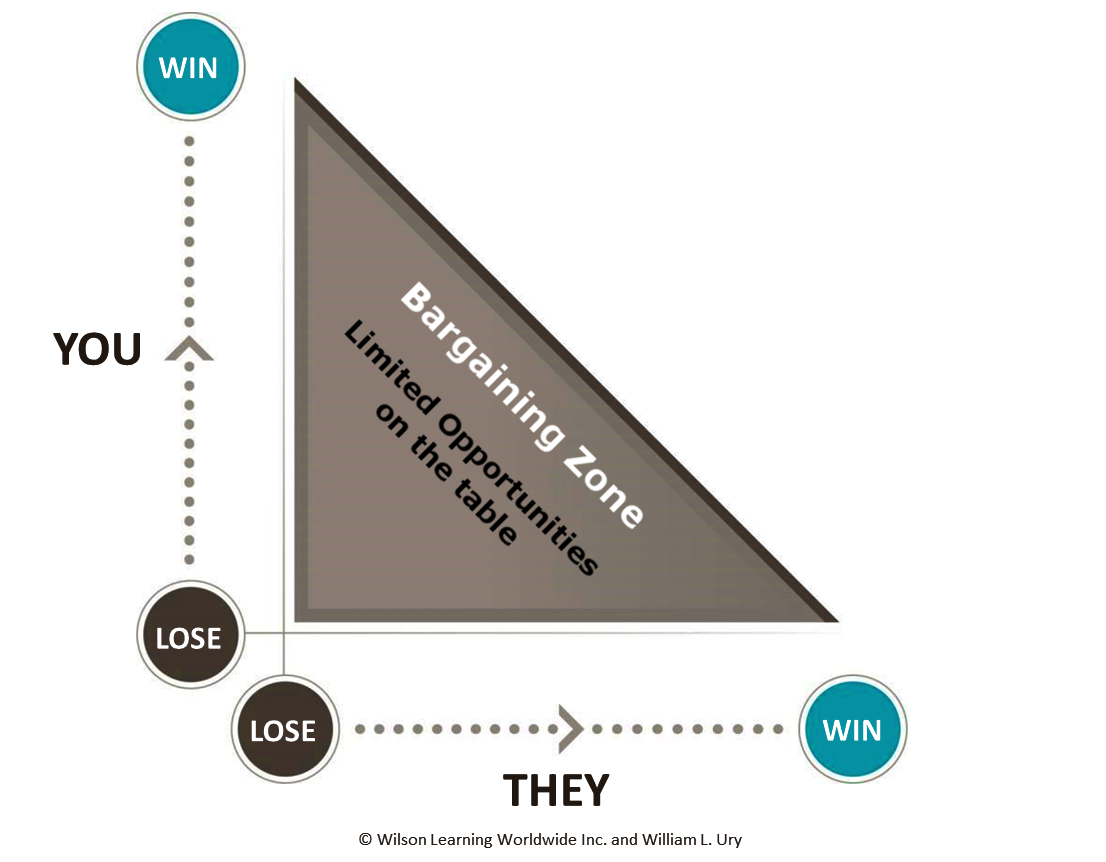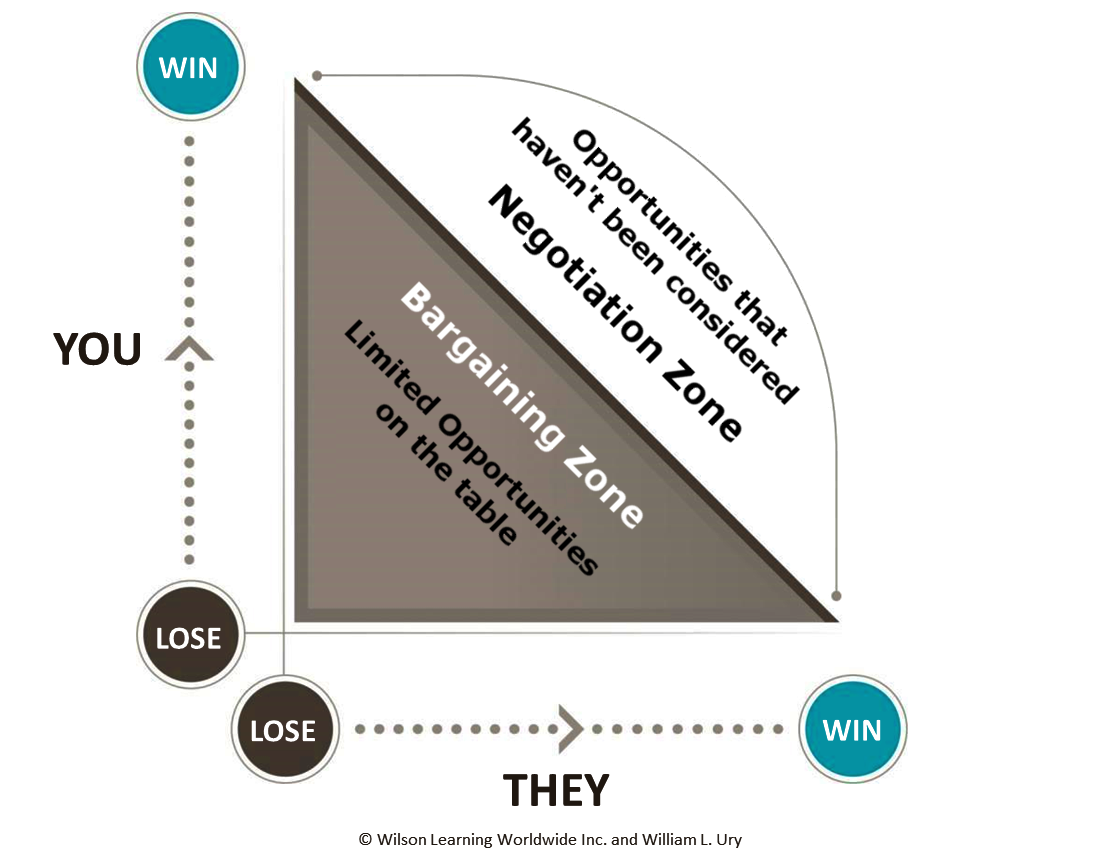Don't Leave Good Business on the Table
5 Negotiation Strategies for Win-Win Sales

"Your price is too high." "Can you match the price your competitor is offering?" "We need to have that service included in your price."
How do your salespeople respond when they hear these kinds of statements from customers? Everyone wants to make the sale in this challenging economy, and it's hard to resist the temptation to cut the margin, reduce the price, or give away "value adds" the customer really should pay for. Of course, everyone is being squeezed. Customers are pressured to control costs and limit spending, and salespeople feel they are forced to compete on price. It seems better to get something rather than nothing. The assumption is that if the customer takes a hard position, the options for bargaining are limited. The most likely outcome is that the salesperson gives up margin and profitability rather than negotiating effectively for a win-win agreement that benefits both parties.

As shown in the graphic, classic bargaining assumes that what is on the table is a "fixed pie," and one of the parties will try to get more of the pie while the other gets less—the classic win-lose result. Traditional bargaining can even lead to a lose-lose situation, where the salesperson accepts a smaller deal with lower margins while the customer also loses out—the lowest price doesn't always translate into the best solution. The perceived opportunities are too limited for either party to be satisfied by the agreement.
There is an alternative to this scenario, even under the present challenging circumstances. A robust principled negotiation process focuses on increasing the size of the pie and expanding the range of opportunities for both the salesperson and the customer. By following five simple steps, salespeople can engage their customers in a give-and-take conversation to explore the interests behind positions and expand the options. This means moving out of the mentality of "hard bargaining" based on firm positions, and into a mode of negotiating based on a handful of powerful principles first articulated by William Ury (business partner of Wilson Learning) and Roger Fisher of the Harvard Negotiation Project. Applying these principles increases the likelihood of achieving win-win agreements that benefit both the salesperson, who is no longer leaving business on the table, and customers, who have more options for better solutions.
5 STRATEGIES FOR SUCCESSFUL NEGOTIATIONS
The following discussion provides an explanation of the five strategies and how they can help salespeople better achieve their goals while bringing greater value to the customer's business.
1. SEPARATE THE PEOPLE FROM THE PROBLEM
In a traditional bargaining situation, the interaction proceeds based on positions and counter-positions. The discussion can easily turn adversarial as the customer raises objections about price or other difficult issues. It is as if the parties are sitting on opposite sides of the table, conducting a tug-of-war to achieve a "win for our side." With a principled negotiation approach, on the other hand, the salesperson focuses on the problem and how to solve it. The idea is to be "hard on the problem and soft on the people." The customer and the salesperson take the perspective of sitting on the same side of the table and, from there, work together to come up with alternative solutions that will benefit both. From this perspective, it's possible to have a productive discussion of the customer's concerns and offer answers and solutions rather than a counter-argument or opposing position that can undermine the relationship.
2. IDENTIFY THE INTERESTS BEHIND THE POSITION
In a traditional bargaining situation, people tend to take a firm position and stick to that position. The focus is on "what I want," and each side is intent on justifying their respective positions. In a principled negotiation process, the focus is on the interests behind the position—the range of issues that are at stake in the negotiation. Paying attention to interests helps uncover the "why" behind a position. While a position tends to be inflexible and fixed, interests open up different perspectives and opportunities to offer options. If a customer takes the position "I must get the lowest price,” interests may include “my boss will want me to show that I got the lowest price," or "my company needs me to help maintain our cash liquidity." The salesperson might say something like, "Now that I understand what is really important to you, if I showed you a way to meet your cash flow needs, would you be interested?"
Interests may also include political concerns such as accommodating other stakeholders' wishes, or a business objective such as attaining a certain level of ROI. A customer may have a personal interest in minimizing risk in making a purchase; another may want to be seen as innovative and leading-edge. Whatever the interests, it's critical to keep asking questions to find out what they are and align with them to smooth the path to mutual agreement.
3. INVENT OPTIONS FOR MUTUAL GAIN

In the diagram, the path to a win-win agreement lies in creating a bigger pie—exploring ways to expand the available options. Knowing the customer's interests will help achieve this objective. For example, suppose the offer on the table is a bundled solution at a certain price. The customer, however, has an interest in keeping costs low because of a company-imposed budget limitation. If interests are openly explored, the salesperson has an opportunity to help solve the problem. Options might be offered—a flexible financing or leasing arrangement might be put on the table, or the solution might be unbundled, allowing the company to purchase elements of the solution in smaller increments. The solution has now been altered to align with the customer's key interests.
The point is, unless you understand the interests behind the position, you may not think of creative options that allow for an "expanded pie" solution.
4. INTRODUCE INDEPENDENT STANDARDS
Independent standards are another way to align with the customer's interests. They represent objective criteria that can be used as a measuring stick for choosing among alternatives and defining some limits. Examples of independent standards might include accepted market value, industry performance benchmarks, other research, or credible third party references. If the salesperson and the customer can agree on such standards, they provide a way to evaluate a proposal from a position of common ground. Both parties can now view the offers on the table from the same perspective.
If you suggest an independent standard, it should be something that is important to the customer. Independent standards should never be used to show the customer that he or she is wrong; rather, the intent should be to help reinforce or support a customer interest. For example, if the interest of the customer is to demonstrate to a manager that the price for the deal is a good value, then an independent standard such as market value/price can be used to justify or reinforce the customer's choice.
5. KNOW YOUR BATNA
In traditional bargaining, negotiation can reach an impasse when either side becomes inflexibly committed to a particular outcome; for example, when the salesperson cannot accept a price below a certain amount, and the customer is determined not to pay above a certain price. It is very important in situations like this that a salesperson has a BATNA—a Best Alternative To a Negotiated Agreement.
Before engaging in a negotiation, salespeople should clarify their overall interests with respect to the account as a whole. Besides closing business, these might include ensuring possibility of future business, expanding relationships with a range of contacts, getting referrals to other customers, or establishing a beachhead with a smaller offering. Any or all of these interests—which are outside of the current negotiation with a particular customer—help inform the salesperson's BATNA. If the customer doesn't agree to all the features of a proposal at a price that is still good business for the salesperson, the BATNA, carefully considered ahead of time, can come into play. The salesperson can negotiate from a position of strength and still walk away with a win—achieving an acceptable outcome while maintaining customer satisfaction and building a trusting relationship with the customer.
It is important to reiterate that the BATNA is an alternative outcome that is acceptable to you and still constitutes a win. Having a good BATNA eliminates some of the pressure to achieve just one ideal outcome and prevents the feeling that you are losing if you don't win that one outcome. In short, the BATNA takes emotion out of the picture and increases the likelihood of rational and effective decision making.
If the salesperson can make an educated guess or find other ways of anticipating the customer's BATNA, it is highly useful, since it helps the salesperson in offering options that are aligned with interests and may even include the customer's BATNA.
CONCLUSION
If there is a key takeaway for salespeople, it is this: A "negotiation" focused only on bargaining over the final price or the features of a contract is limiting and likely to result in an unsatisfactory outcome for at least one and maybe both parties. To avoid leaving business on the table, salespeople need to move away from a bargaining approach and toward engaging in a principled negotiation process by developing the confidence and skills to "separate the people from the problem," identify and respond to customers' interests (not just their positions), generate options to expand the pie, use independent standards for objective evaluation, and know their own BATNAs. If they are able to master these five strategies, they can increase both the probability of win-win outcomes and the likelihood of more—and more profitable—sales.
To learn more, contact Wilson Learning at 1.800.328.7937 or complete the online form.







 Please complete this form to download Don't Leave Good Business on the Table | 5 Negotiation Strategies for Win-Win Sales.
Please complete this form to download Don't Leave Good Business on the Table | 5 Negotiation Strategies for Win-Win Sales.



